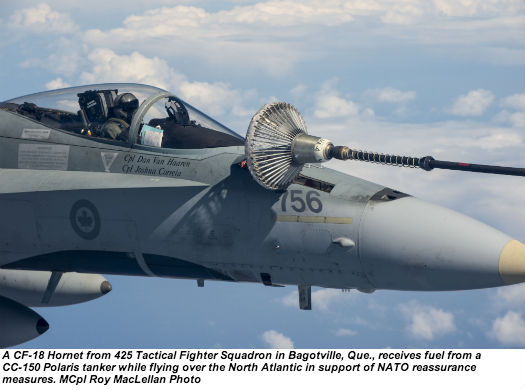Estimated reading time 5 minutes, 49 seconds.
In August, the Royal Canadian Air Force stepped up its involvement in Operation Reassurance in Eastern Europe from an interoperability training deployment in Romania to a NATO policing mission over the Baltic states of Lithuania, Estonia and Latvia.
Six Boeing CF-18 Hornets with rotating aircrews and some 200 support personnel had been stationed in the north-central Romanian region of Transylvania since early May. All single-seaters from 425 Tactical Fighter Squadron at 3 Wing in Bagotville, Que., they were flown in via Keflavik on the southwestern tip of Iceland, refueling from a CC-150 Polaris tanker.
Operating from the Romanian Air Force’s 71st Air Base at Ĉampia Turzii in Transylvania, the Hornet pilots, overseen by their squadron commander, LCol Dave “Super Dave” Pletz, had done three rotations by the time the Romanian mission finished. While 414 Squadron had the lead, 409 Tactical Fighter Squadron at 4 Wing in Cold Lake, Alta., was also involved.
LCol Jonanathan Nelles, deputy commander and chief of staff for the Romanian operation, told Skies that the Hornet pilots were flying daily during the week and sometimes on weekends as needed. “It’s been pretty much exclusively with the Romanian Air Force, but we’re flying in an area of Europe where our fighter operations have not had a lot of experience,” the career helicopter pilot explained as the first element of Op Reassurance was winding down. “We’ve been developing our knowledge of the surrounding airspace and . . . high levels of interoperability with the NATO partner.”
The Hornet and Romanian MiG-21 Lancer pilots have also been working with NATO’s internationally-crewed E3A Sentry surveillance and early-warning platforms, highly modified Boeing 707s flown out of Geilenkirchen, Germany. In the later stages of the Romanian deployment, the Hornet pilots completed a close air support exercise, working with the Romanian Army and Special Forces and their Joint Tactical Air Controllers.
The Romanian Air Force’s (RoAF) Soviet-era fighters are less technologically-sophisticated than the Hornets; however, they reportedly worked well together on air defence, air superiority and tactical support exercises.
The MIG-21 Lancer is a clear-weather interceptor first flown in 1957. Since modernized and powered by a single Tumanski R-11-300 turbojet and capable of Mach 2.1 at altitude, the Lancer was nicknamed “Balalaika” because its pencil-shaped fuselage and delta wings resembled the Russian stringed instrument.
Today, only 36 Lancers are flown by the RoAF, but they have been updated to use Western and Eastern armaments. They are due to be replaced by 2017 with a squadron of 12 F-16AM/BM fighters purchased from Portugal, which is reducing its fleet.
“The MIG is . . . a very capable aircraft and the Romanians proved they use it to the limits of their capability,” said Nelles. “But it’s more than just simply combining areas of technology; it’s developing a rapport with our host and the cadre of personnel and also understanding their procedures and how they have done things in the past, sharing with them how we do things with our aircraft. As well, going into the future, the Romanians are programming to take delivery of F-16s, so it’s helping them also to introduce to them some of the challenges of operating a more modern fighter capability.”
The RCAF evidently is delighted with the results. “The degree of cooperation . . . has exceeded initial expectations,” it said in a statement, adding that it had been “outstanding” in all aspects. “This has been an excellent opportunity to develop our skills and enhance our ability to operate with . . . allies while building cohesion within the alliance.”
From Ĉampia Turzii, the RCAF transitioned in late August to Šiauliai, the unofficial capital of northern Lithuania, to begin the policing action, a continuation of Op Reassurance which is due to run until year’s end with RCAF air and ground crews rotating in and out. The Canadian government confirmed the extension in early July, explaining that it reinforced Canada’s “continued commitment to promoting security and stability in Central and Eastern Europe, and resolute support for NATO collective defence.”
This is Canada’s first contribution to Baltic policing, which began in 2004 with a Belgian deployment of General Dynamics F-16AM Fighting Falcons. Since then, NATO members have taken turns sending fighters to police the airspace as Estonia, Latvia and Lithuania lack the resources to defend against aerial intruders.
NATO recently announced plans to increase its fighter presence there and the Hornet pilots will be patrolling in conjunction with Belgian and Portuguese F-16AMs and Eurofighter Typhoons flown by the German Luftwaffe.
Although a first for the RCAF in the Baltics, the mission is similar to Operation Ignition in the spring of 2013, when Hornets from Bagotville and Cold Lake, flying out of Keflavik, contributed to Iceland’s peacetime preparedness as part of a NATO airborne surveillance and interception exercise.

